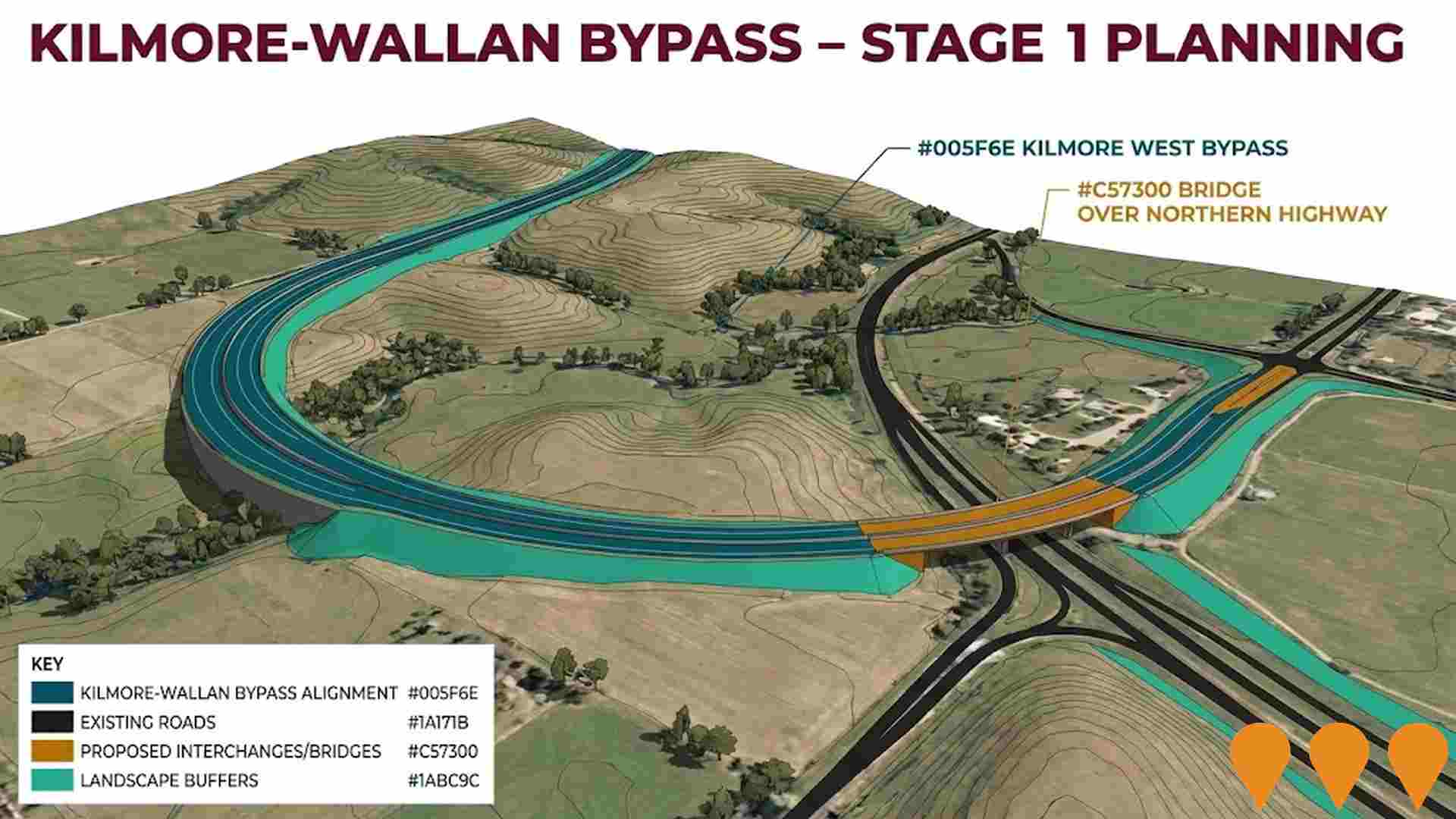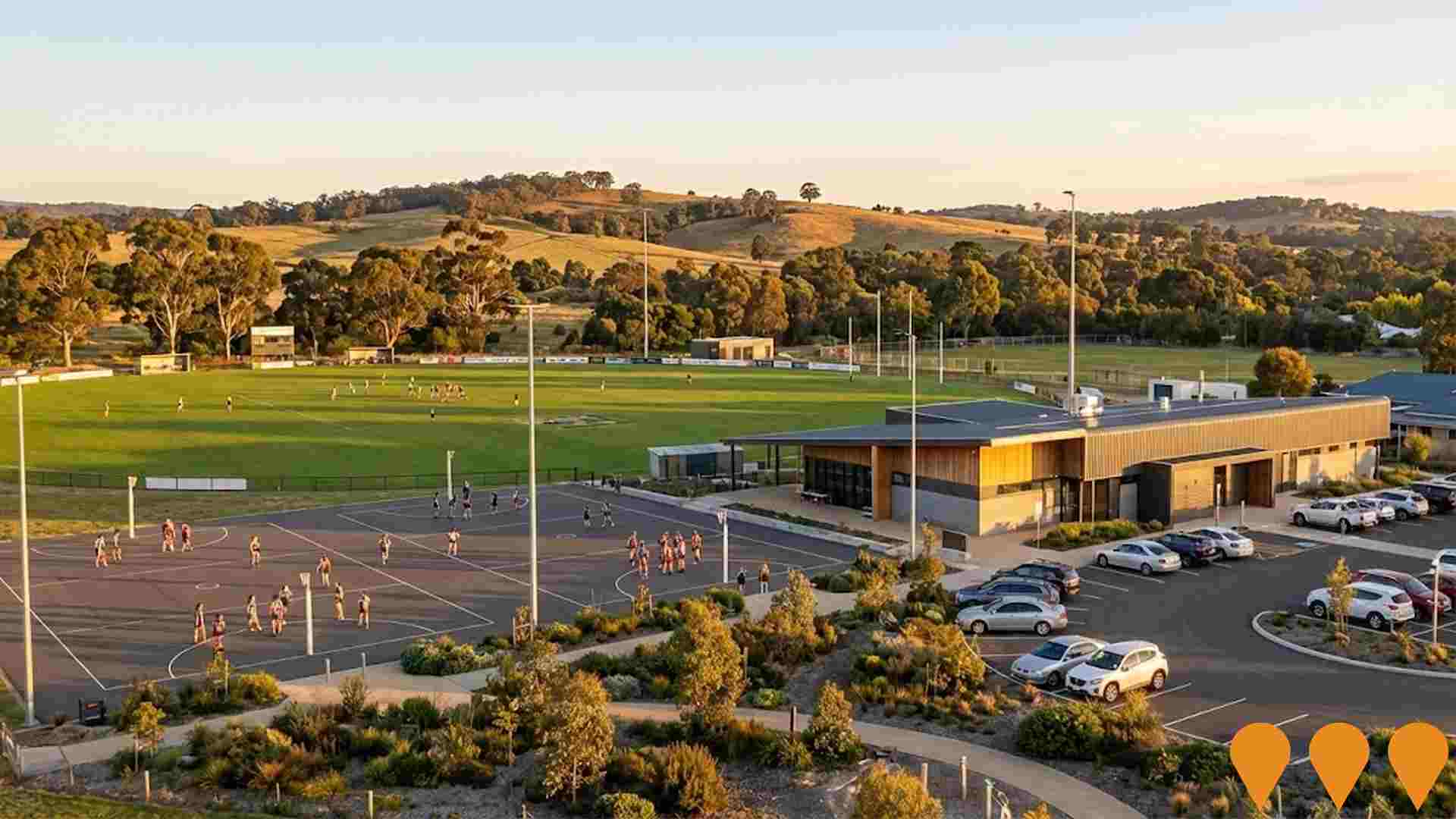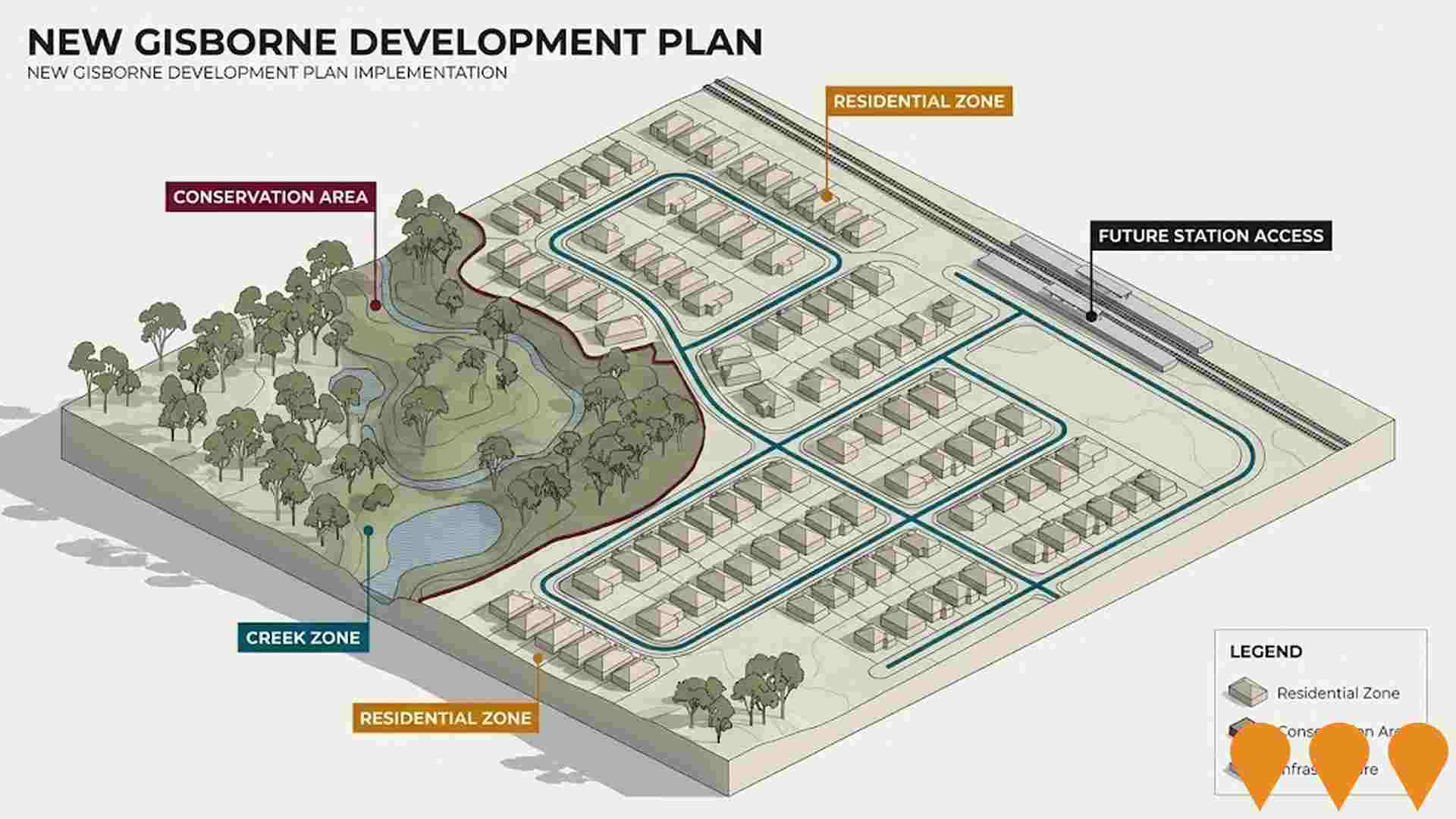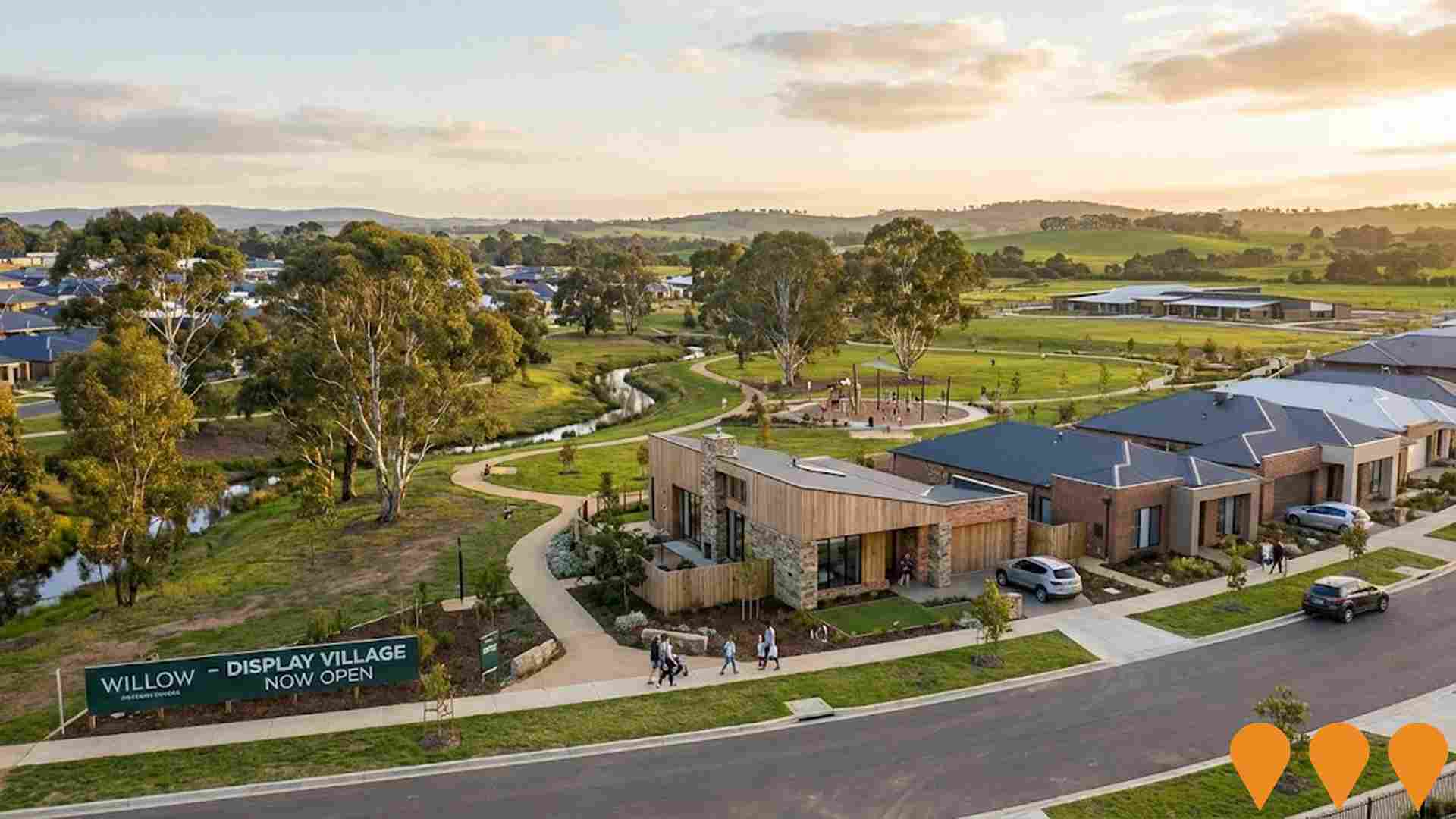Chart Color Schemes
est. as @ -- *
ABS ERP | -- people | --
2021 Census | -- people
Sales Activity
Curious about local property values? Filter the chart to assess the volume and appreciation (including resales) trends and regional comparisons, or scroll to the map below view this information at an individual property level.
Find a Recent Sale
Sales Detail
Population
Romsey lies within the top quartile of areas nationally for population growth performance according to AreaSearch analysis of recent, and medium to long-term trends
Romsey's population is around 11,537 as of Aug 2025. This reflects an increase of 772 people since the 2021 Census, which reported a population of 10,765 people. The change is inferred from the estimated resident population of 11,489 from the ABS as of June 2024 and an additional 109 validated new addresses since the Census date. This level of population equates to a density ratio of 18.5 persons per square kilometer. Over the past decade, Romsey has demonstrated resilient growth patterns with a compound annual growth rate of 2.2%, outpacing the SA3 area. Population growth for the area was primarily driven by natural growth contributing approximately 53.3% of overall population gains during recent periods.
AreaSearch is adopting ABS/Geoscience Australia projections for each SA2 area, as released in 2024 with a base year of 2022. For any SA2 areas not covered by this data, AreaSearch is utilising the VIC State Government's Regional/LGA projections released in 2023 with adjustments made employing a method of weighted aggregation of population growth from LGA to SA2 levels. Growth rates by age group from these aggregations are also applied across all areas for years 2032 to 2041. Considering the projected demographic shifts, a significant population increase in the top quartile of national areas is forecast, with the area expected to grow by 4,734 persons to 2041 based on the latest population numbers, recording a gain of 40.6% in total over the 17 years.
Frequently Asked Questions - Population
Development
AreaSearch assessment of residential development activity positions Romsey among the top 25% of areas assessed nationwide
Romsey has recorded approximately 70 residential properties granted approval annually. Over the past five financial years, from FY21 to FY25354 homes were approved, with a further 7 approved in FY26. On average, for every home built over these five years, there have been 3.2 new residents.
This demand significantly exceeds new supply, typically leading to price growth and increased buyer competition. New properties are constructed at an average expected cost of $578,000, which is somewhat higher than regional norms, reflecting quality-focused development. In FY26, Romsey has seen $7.6 million in commercial approvals, indicating limited focus on commercial development compared to residential.
When compared to Greater Melbourne, Romsey shows approximately 75% of the construction activity per person and ranks among the 60th percentile of areas assessed nationally for new development. New development in Romsey consists of 94.0% standalone homes and 6.0% attached dwellings, preserving the area's low density nature and attracting space-seeking buyers. With around 254 people per dwelling approval, Romsey shows a developing market with population forecasts indicating an increase of 4,686 residents by 2041. If current development rates continue, housing supply may not keep pace with population growth, potentially increasing competition among buyers and supporting stronger price growth.
Frequently Asked Questions - Development
Infrastructure
Romsey has strong levels of nearby infrastructure activity, ranking in the top 30% nationally
AreaSearch has identified 19 infrastructure projects that could impact the area's performance. Key projects include Kilmore-Wallan Bypass, Gisborne Business Park Development, C153 Willowbank Road Commercial Rezoning, and Macedon Ranges Sports Precinct. The following list details those considered most relevant.
Professional plan users can use the search below to filter and access additional projects.
INFRASTRUCTURE SEARCH
 Denotes AI-based impression for illustrative purposes only, not to be taken as definitive under any circumstances. Please follow links and conduct other investigations from the project's source for actual imagery. Developers and project owners wishing us to use original imagery please Contact Us and we will do so.
Denotes AI-based impression for illustrative purposes only, not to be taken as definitive under any circumstances. Please follow links and conduct other investigations from the project's source for actual imagery. Developers and project owners wishing us to use original imagery please Contact Us and we will do so.
Frequently Asked Questions - Infrastructure
Gisborne Futures Structure Plan
Comprehensive planning framework for Gisborne and New Gisborne growth to 2050. Establishes settlement boundary, identifies future land uses for retail, employment, housing, open space. Proposes twin villages concept with new town centre for New Gisborne.

Kilmore-Wallan Bypass
Planning for a bypass to relieve traffic congestion and reduce heavy vehicles through Kilmore's main streets. Preferred alignment west of Kilmore and Wallan. Stage 1 focuses on the section west of Kilmore township, with recent approval of Planning Scheme Amendment C168mith effective September 5, 2024, to facilitate land acquisition.

Gisborne Business Park Development
New commercial and industrial development providing employment opportunities for Gisborne region. Mixed-use business park with technology focus, supporting local economic diversification beyond tourism and residential.

Macedon Ranges Sports Precinct
Major regional sports facility development providing multipurpose courts, ovals, and community facilities. Serving broader Macedon Ranges region with high-quality sports infrastructure for multiple codes and community events.

New Gisborne Development Plan Implementation
Planning framework for new growth area west of Station Road, New Gisborne. Adopted by Council March 2014, sets out development guidelines for expanded residential areas with conservation management requirements.

Willow Gisborne Community
House and land packages in established community in the heart of Gisborne, gateway to Macedon region, 45 minutes from Melbourne CBD. Delivered by ID_Land, part of ID_CORP's diversified property group with $4.5 billion portfolio.

Willowbank Primary School
New Victorian Government primary school delivered by the Victorian School Building Authority to serve growing families in Gisborne. The campus opened in 2022 with facilities including an administration and library building, performing arts and PE building, two learning neighbourhoods, outdoor courts, a sports field, bike storage and playgrounds. A co-located kindergarten operates on site.

Willow, Gisborne
Willow, Gisborne is a masterplanned residential community by ID_Land in the Macedon Ranges, delivering more than 600 residential lots with parklands, waterways, a future primary school and a display village, offering house and land packages that combine country lifestyle with access to Gisborne town centre and Melbourne.

Employment
Employment conditions in Romsey demonstrate exceptional strength compared to most Australian markets
Romsey has a skilled workforce with an unemployment rate of 2.3% as of June 2025. This is below Greater Melbourne's rate of 4.6%.
Workforce participation in Romsey is on par with Greater Melbourne's 64.1%. The dominant employment sectors among residents include construction, health care & social assistance, and education & training. Construction shows strong specialization with an employment share of 1.7 times the regional level. Conversely, professional & technical has lower representation at 5.4% versus the regional average of 10.1%.
Employment levels increased by 4.2% during the year to June 2025 while labour force increased by 4.4%, causing the unemployment rate to rise by 0.2 percentage points. Jobs and Skills Australia's national employment forecasts from May 2025 project national employment growth of 6.6% over five years and 13.7% over ten years. Applying these projections to Romsey's employment mix suggests local growth of approximately 6.0%% over five years and 12.5% over ten years.
Frequently Asked Questions - Employment
Income
Income analysis reveals strong economic positioning, with the area outperforming 60% of locations assessed nationally by AreaSearch
AreaSearch's latest postcode level ATO data for financial year 2022 shows that Romsey has a higher median income of $55,968 and an average income of $70,336 compared to the national averages. In Greater Melbourne, the median income is $54,892 with an average income of $73,761. Based on Wage Price Index growth of 12.16% since financial year 2022, estimated incomes as of September 2025 would be approximately $62,774 (median) and $78,889 (average). According to the 2021 Census, Romsey's household, family and personal incomes rank at the 61st percentile nationally. The income bracket of $1,500 - 2,999 is dominant in Romsey with 34.6% of residents, similar to the broader metropolitan region at 32.8%. After housing costs, 86.3% of income remains for other expenses, and Romsey's SEIFA income ranking places it in the 6th decile.
Frequently Asked Questions - Income
Housing
Romsey is characterized by a predominantly suburban housing profile, with ownership patterns similar to the broader region
Romsey's dwelling structures, as per the latest Census evaluation, consisted of 98.2% houses and 1.8% other dwellings. In comparison, Melbourne metro had 94.7% houses and 5.3% other dwellings. Home ownership in Romsey was at 36.1%, similar to Melbourne metro's level. The remaining dwellings were either mortgaged (53.0%) or rented (10.9%). The median monthly mortgage repayment in Romsey was $1,928, below the Melbourne metro average of $2,014. The median weekly rent figure in Romsey was $365, compared to Melbourne metro's $400. Nationally, Romsey's mortgage repayments were higher than the Australian average of $1,863, while rents were lower than the national figure of $375.
Frequently Asked Questions - Housing
Household Composition
Romsey features high concentrations of family households, with a lower-than-average median household size
Family households constitute 79.9% of all households, including 37.6% couples with children, 31.9% couples without children, and 10.0% single parent families. Non-family households comprise the remaining 20.1%, with lone person households at 18.3% and group households making up 1.8%. The median household size is 2.7 people, which is smaller than the Greater Melbourne average of 2.8.
Frequently Asked Questions - Households
Local Schools & Education
Romsey performs slightly above the national average for education, showing competitive qualification levels and steady academic outcomes
The area's university qualification rate is 22.1%, significantly lower than Greater Melbourne's average of 37.0%. Bachelor degrees are the most common at 15.2%, followed by postgraduate qualifications (3.6%) and graduate diplomas (3.3%). Vocational credentials are prevalent, with 40.7% of residents aged 15+ holding them, including advanced diplomas (11.9%) and certificates (28.8%). Educational participation is high at 28.7%, comprising primary education (10.9%), secondary education (8.7%), and tertiary education (3.3%).
Romsey has a network of 7 schools educating approximately 872 students, with typical Australian school conditions (ICSEA: 1018) and balanced educational opportunities. The schools include 6 primary and 1 K-12 school. School capacity is limited at 7.6 places per 100 residents compared to the regional average of 16.4, leading many families to travel for schooling. Note: where schools show 'n/a' for enrolments, please refer to the parent campus.
Frequently Asked Questions - Education
Schools Detail
Nearby Services & Amenities
Transport
Transport servicing is low compared to other areas nationally based on assessment of service frequency, route connectivity and accessibility
Romsey has 15 operational public transport stops. These include a mix of train and bus services. There are 16 routes serving these stops, offering a total of 619 weekly passenger trips.
Transport accessibility is limited, with residents typically located 892 meters from the nearest stop. On average, there are 88 daily trips across all routes, equating to approximately 41 weekly trips per individual stop.
Frequently Asked Questions - Transport
Transport Stops Detail
Health
Health outcomes in Romsey are marginally below the national average with common health conditions slightly more prevalent than average across both younger and older age cohorts
Romsey's health indicators show lower-than-average results, with common health conditions slightly more prevalent across both younger and older age groups compared to the norm. Private health cover is very high here, at approximately 55% of the total population (~6,345 people), which is higher than Greater Melbourne's 58.9%.
The most frequent medical conditions are asthma and mental health issues, affecting 8.9% and 8.4% of residents respectively, while 67.5% claim to be completely free of medical ailments compared to Greater Melbourne's 69.3%. Romsey has 18.7% of residents aged 65 and over (2,159 people). Health outcomes among seniors are above average, performing better than the general population in health metrics.
Frequently Asked Questions - Health
Cultural Diversity
Romsey is considerably less culturally diverse than average when assessed alongside AreaSearch's national rankings for language and cultural background related metrics
Romsey's cultural diversity was found to be below average. 89.0% of its population were born in Australia, with 91.2% being citizens and 96.1% speaking English only at home. Christianity is the main religion in Romsey, comprising 47.8% of people.
Judaism is overrepresented compared to Greater Melbourne, making up 0.1% of Romsey's population versus 0.1%. The top three ancestry groups are Australian (30.8%), English (29.3%), and Irish (10.4%). Notably, Maltese are overrepresented at 1.8% in Romsey compared to the regional figure of 2.1%. Scottish representation is also slightly higher at 8.6%, versus 8.8% regionally, and Italian representation is at 4.0%, compared to 3.8% regionally.
Frequently Asked Questions - Diversity
Age
Romsey's median age exceeds the national pattern
Romsey's median age is 41 years, which is higher than Greater Melbourne's average of 37 and slightly older than Australia's median of 38. Comparing Romsey with Greater Melbourne, the 55-64 age cohort is more prevalent at 13.8% compared to the local average, while the 25-34 age group is underrepresented at 10.7%. According to the 2021 Census, the population aged 35-44 has increased from 12.3% to 14.2%, and the 75-84 cohort has risen from 4.9% to 6.4%. Conversely, the 45-54 age group has decreased from 14.6% to 12.7%, and the 25-34 age group has fallen from 12.1% to 10.7%. Future demographic projections indicate significant changes in Romsey's age profile by 2041, with the strongest growth expected in the 45-54 cohort, projected to increase by 57%, adding 839 residents for a total of 2,300.

